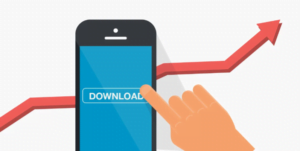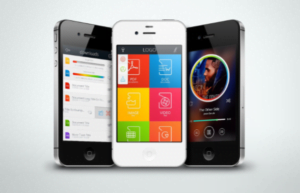Crafting an app that soars to the top ranks of major app stores is no walk in the park. The key to smartphone application triumph often hinges on the distinctive nature, utility, or sheer addictiveness of your digital creation. In the Google Play Store for Android and the Apple App Store for iOS, there’s a sea of apps spanning every conceivable theme, making it an uphill battle to stand out. Ultimately, an app lacking in allure, affordability, or perceived indispensability won’t inspire installs.

Even if your app is exceptional and adored by users, achieving visibility on these major app platforms can remain an arduous task. Here are several strategies to amplify your app downloads:
- Craft Excellence: A subpar app won’t garner downloads or retain users. Rigorous testing is paramount to ensure your app remains crash-free. It should be user-friendly, with any ads or promotional elements serving their purpose without causing frustration. Apps that falter or confound users will amass negative ratings and swift uninstalls, plummeting in the rankings.
- Encourage Reviews: Positive reviews are a game-changer for app success. A plethora of positive feedback boosts your app’s standing in the store, as users often peruse reviews before installing. Favorable reviews lead to more recent downloads, a pivotal factor in rising up the app store ranks. Reviews also offer an avenue for direct communication with users to address bugs, issues, or concerns.
- Foster Sharing: Referrals are vital for sustained growth. Incentivize users within your app to refer friends by offering rewards, such as discounts, in-game bonuses, or other value-added perks.

- Embrace ASO: App Store Optimization (ASO) is instrumental in elevating your app’s visibility. ASO fine-tunes various factors, enhancing your app’s ranking within the store. Metadata elements like keywords, user reviews, descriptions, and images are evaluated by app marketplaces. Some keywords are fiercely competitive, while others present less of a challenge. Collaborating with ASO experts ensures your app is optimized for discoverability, a cost-effective method for driving installations.
- Leverage App Install Advertising: Complement ASO with mobile app advertising to drive downloads and engage new users. Platforms like Facebook Ads’ mobile app install objective, App Installs on Twitter Ads, or Google Ads App Campaigns can jumpstart your efforts. Numerous mobile ad networks can expand your app’s reach, but bear in mind that investing in app install ads isn’t a long-term solution if users swiftly uninstall your app.
In conclusion, these are just a few strategies to contemplate if you’re determined to boost your app store installations. Remember, a dash of optimization and savvy digital marketing can propel your app a long way. If you’d like to delve deeper into these strategies, don’t hesitate to reach out to us for further guidance.
Unlocking App Success: 15 Innovative Strategies to Skyrocket Downloads
After dedicating substantial time and resources to develop your mobile app, the ultimate goal is to see it thrive with a substantial user base. However, convincing users to hit the coveted “Install” button can be a challenging feat.
The encouraging news is that numerous tried-and-tested methods can significantly increase app downloads, some of which may not be as obvious as paid social media advertising. As a savvy product manager or startup founder, you’re likely familiar with the more conventional approaches. In this article, we’ll delve into lesser-known yet highly effective tactics that have propelled numerous top apps to millions of downloads.

15 Techniques for Amplifying Mobile App Downloads:
- Elevate Visibility with App Store Optimization (ASO)
- Broaden Your Audience with App Localization
- Establish a Website (or Enhance Your Current One)
- Harness the Power of Content Marketing
- Dominate Social Media
- Collaborate with Influencers
- Craft a Compelling Demo Video
- Prompt Users to Leave Ratings and Reviews
- Encourage Referrals
- Elevate Your Branding
- Experiment with Pricing for Chart Success
- Transition to a Freemium or Paymium Model
- Cultivate Press Relationships
- Harness the Potential of Affiliate Marketing
- Incorporate Social Features
Whether you’re aiming to acquire your initial hundred users or striving for five-figure milestones, these battle-tested strategies can help you reach your objectives. Just remember to keep them close to your chest when it comes to competitors…
1. Elevate Visibility with App Store Optimization (ASO)
The primary way people discover new apps is through Apple’s App Store or the Google Play Store. While securing an “Editor’s Choice” spot is the dream, it’s not entirely within your control.
What you can influence, however, is your app listing. App Store Optimization (ASO) involves optimizing your app’s page to make it as appealing and discoverable as possible. This entails incorporating highly relevant keywords, crafting an attention-grabbing title, crafting a compelling app description, and showcasing captivating screenshots.
Many apps struggle with downloads due to deficiencies in one or more of these areas. To enhance your download numbers, analyze the listings of your key competitors and conduct research to determine what your ideal users are likely to search for. Don’t overlook the importance of adapting your listing for different regions, as each language has its own set of keywords. Services like OneSky can be invaluable for this purpose.
2. Broaden Your Audience with App Localization
The App Store and Google Play Store offer a unique opportunity to reach users globally. However, users are unlikely to download an app they can’t comprehend.
Translation can help you reach users in various parts of the world, but to truly gain traction, consider taking the extra step of localization. This involves tailoring your app to different languages, cultures, and locations, encompassing translation, content optimization, and design adjustments. It can even extend to your app’s listing.
Effective localization not only unlocks new global audiences but also enhances the user experience for those downloading your app in these new regions, resulting in more positive reviews and word-of-mouth referrals.
3. Establish a Website (or Enhance Your Current One)
Just like any online product, your app should ideally have its own website. It’s a fundamental aspect of digital marketing.
The primary purpose of your website should be discoverability. It doesn’t need to be overly elaborate, but it should prioritize Search Engine Optimization (SEO). People often search for new apps not only within app stores but also through search engines like Google. Having a website allows you to capture these potential users and present your app’s best features within a controlled digital space.
On your landing page, incorporate attention-grabbing images, a teaser video, and a compelling call-to-action that links to your download page.

4. Harness the Power of Content Marketing
From photo editing to financial management, many apps can effectively promote themselves through content marketing.
This could involve adding blogs to your app’s website, creating video tutorials on platforms like YouTube, or even launching a podcast series. Evernote, for instance, has successfully implemented this strategy by regularly sharing user survey results and producing content related to productivity.
Relevant content naturally attracts users, and you can subtly introduce your app within each post, video, or episode. Moreover, consistently publishing content can provide a significant boost to your website’s SEO.
5. Dominate Social Media
While some users prefer reading blogs, others find content sharing on social media to be a more effective way to drive downloads.
Consider the example of Calm, an app designed to help people relax and meditate. The Calm team regularly shares content on Instagram, ranging from soothing images and stress management tips to heartfelt videos from satisfied users. These posts may attract individuals who weren’t initially searching for a meditation app but were drawn to the content and eventually downloaded Calm through the bio link.
Social media platforms such as Facebook, Twitter, and LinkedIn offer a direct means to encourage downloads by incorporating links within your posts.
6. Collaborate with Influencers
Not every startup possesses the resources or expertise to amass a massive following on social media. Nevertheless, this doesn’t mean you should abandon social media marketing.
To introduce your app to a new audience, consider partnering with social media influencers. These individuals dedicate substantial time engaging with their followers, and by offering a sponsorship package, many will be eager to discuss and demonstrate your app in their social media posts.
The key to this approach is selecting the right influencers to collaborate with. While prominent influencers can help you reach millions, working with influencers who have a smaller yet highly engaged audience centered around a specific interest can yield significant success.
7. Craft a Compelling Demo Video
Movie studios release trailers for blockbuster films for a reason – they generate interest.
Creating a demo or promotional video for your app enables potential users to gain a glimpse of your product before committing. Your video can highlight its best features, elucidate complex functionalities, and showcase the app in action.
This strategy is particularly crucial for Android apps, as the Google Play Store accommodates video previews, unlike Apple’s App Store, which solely supports screenshot images.
8. Prompt Users to Leave Ratings and Reviews
When potential users encounter your app, there’s a high probability they’ll glance at your ratings. The more discerning ones might delve into user reviews to seek feedback from other customers.
Both these aspects of your app listing can significantly influence the number of downloads you secure. Additionally, app stores tend to favor apps that offer a positive user experience.
The most effective way to enhance your ratings and reviews is by requesting feedback from your existing users. Many apps employ pop-up prompts that appear after the app has been used for a specific duration or opened a certain number of times. This not only ensures more users leave ratings and reviews but also increases the likelihood of receiving input from individuals with positive opinions, creating a potent form of “social proof.”
9. Encourage Referrals
No marketing approach can rival the impact of referrals. People are far more inclined to trust recommendations from friends rather than advertisements or articles, especially if your app incorporates a social element.
While a few of your delighted users might spontaneously spread the word, most individuals require an incentive to make the effort. This is why many apps feature a referral system, where users are rewarded when their friends and family download the same app and create an account. Implementing this feature alone can significantly boost your downloads.
10. Elevate Your Branding
With 1.96 million apps on iOS and 3.48 million on Android, the likelihood of direct competition is high. To stand out in this crowded landscape, your branding must be impeccable.
 The first elements potential users encounter in search results are your app icon and app name. If your download numbers are disappointing, it might be due to weaknesses in one or both of these aspects. App icons should be attention-grabbing and visually appealing, conveying the impression of a high-quality product. Simultaneously, your app’s name should clearly convey its purpose and include useful keywords, as this plays a role in search visibility.
The first elements potential users encounter in search results are your app icon and app name. If your download numbers are disappointing, it might be due to weaknesses in one or both of these aspects. App icons should be attention-grabbing and visually appealing, conveying the impression of a high-quality product. Simultaneously, your app’s name should clearly convey its purpose and include useful keywords, as this plays a role in search visibility.
11. Experiment with Pricing for Chart Success
Aside from search and “Editor’s Choice” collections, app charts are another primary avenue where users discover new apps. Achieving a spot in the top ten can generate significant attention for your app.
For paid and freemium apps, reaching these coveted ranks may seem like a distant goal. However, there is a strategy to attain it. Many developers leverage limited-time price reductions to stimulate a surge in downloads within a short timeframe. This, in turn, propels the app higher in the charts, exposing it to a larger audience. Even if you’re only making $0.99 on each purchase during a given week, the resulting increase in brand awareness can yield greater long-term returns.
12. Transition to a Freemium or Paymium Model
With a plethora of free apps available, convincing users to part with their money upfront can be challenging. Consequently, many leading developers now embrace the freemium pricing model.
Offering your app as a free download can undoubtedly boost your download numbers. Furthermore, the freemium model has the potential to generate substantial revenue and profit across various app categories. If you’re not prepared to provide users with a free taste of your product, consider the paymium model, where users pay a small fee for a “lite” version of your app with the option to upgrade via an in-app purchase or separate download.
13. Cultivate Press Relationships
Creating buzz around your product becomes considerably easier when you can pitch it to an established audience. Remarkably, you can delegate the hard work to someone else.
News sites and niche blogs are perpetually interested in covering innovative new products. All you need to do is pitch to writers and provide a newsworthy press release.
14. Harness the Potential of Affiliate Marketing
 Even if you don’t secure free press coverage, there are alternative methods to increase your app’s exposure.
Even if you don’t secure free press coverage, there are alternative methods to increase your app’s exposure.
Affiliate marketing operates on the principle that any site linking to your app receives a modest commission when a reader subsequently downloads or purchases your product. While the payout for each individual click may be modest, blogs with thousands of readers can generate substantial monthly revenue from such programs. In return, your app’s page can experience a significant surge in traffic.
15. Incorporate Social Features
Sometimes, the mere inclusion of social aspects within your app can motivate users to refer it to their friends.
If you’re seeking to boost your downloads, consider adding social functionality, a relatively straightforward feature to implement.
Incorporate these strategies wisely, adapt them to your unique app and audience, and watch your app downloads soar. Remember, the app landscape is ever-evolving, so continuous experimentation and innovation are key to maintaining and increasing your user base.
Author
-

Kieran Scott is a Senior Marketing Manager on the blog team with a wealth of experience writing about your favorite social media platforms, sales trends, and how you can keep your customers happy. He’s the sole manager of Breaking the Blueprint, a DI&B blog series dedicated to addressing the unique challenges and opportunities of underrepresented entrepreneurs, growing its traffic by more than 50% in just one year. When he’s away from his keyboard, you’ll probably find him trying new recipes and leaving his heart out on the soccer field. At the same time. He’s based in Brooklyn, NY.
View all posts







